The iPhone 7 and iPhone 7 Plus Review: Iterating on a Flagship
by Joshua Ho & Brandon Chester on October 10, 2016 8:00 AM EST- Posted in
- Smartphones
- Apple
- Mobile
- iOS
- iOS 10
- iPhone 7
- iPhone 7 Plus
Battery Life
As-is, one of the most important factors for upgrading a smartphone remains battery life, due to a combination of inherent demand for a phone that can last 2-3 days of use and applications that demand enormous amounts of performance over long periods of time. Apps like WeChat are fairly notorious for holding wakelocks on Android and never really stopping background resource usage so there’s also an element of OS optimization that goes with keeping real-world in battery life up to expectations.
In order to test these things, we’ve spent the past year developing and validating a new web browsing battery life test which updates the sites used and introduces a scrolling component which attempts to better model how a number of tasks are not simply race to sleep and contain a steady-state component. We’ve also updated our rundown tests to better reflect reality and maintain appropriate loads as some devices with high-end SoCs and low display resolution were outpacing our testing. As always, all displays are set to 200 nits with location and other background services disabled to reach a useful relative comparison.

Looking at our WiFi web browsing test, it’s genuinely ridiculous how well the iPhone 7 and 7 Plus perform in this test. The iPhone 7 Plus is definitely down on battery life compared to the Galaxy S7 Edge, but it’s within 5% despite using a battery that’s almost 20% smaller. The iPhone 7 is actually comparable in battery life to the iPhone 7 Plus, and is significantly above the Galaxy S7 with Exynos 8890. Of course, the iPhone 7 has a significantly lower resolution display and a smaller battery, but the nature of smartphone design is that larger devices will generally have better battery life because the board area needed remains mostly constant while the amount of area for battery increases. The iPhone 7 has significantly improved in battery life here, likely due to a combination of A10 Fusion's power optimizations – particularly the small CPU cores – and the removal of the headphone jack, which teardown photos show to have been partially replaced with the battery. However if you do the math efficiency sees a relatively minor uplift.
One other interesting point is that Brandon accidentally ran the battery test on his iPhone 7 with a Safari Content Blocker enabled, which blocked all the ads on the sites that the test visits. In doing so, battery life rose from the normal result of 9.22 hours to 10.03 hours, demonstrating how the increased workload and long-running network requests from ads and trackers really impacts a smartphone's battery life. It's also worth noting that our test constantly cycles through pages, so if you spend a lot of time on a single page with ads you could see an even greater difference.
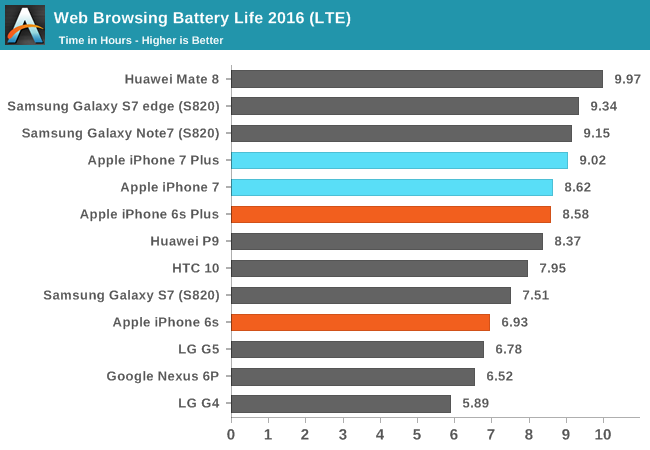
Moving on to LTE battery life the iPhone 7 and 7 Plus both slip a bit, but remain impressive. I suspect that the 20nm Qualcomm modem here is not well-equipped to handle the endless stream of ads that is increasingly a part of most websites. As ads tend to stream in incredibly slowly, the standby power of the modem is a significant factor. Snapdragon 820 devices don’t see nearly the impact here that the iPhone 7 and 7 Plus as their modem is on 14LPP rather than 20SoC. The iPhone 7 remains above the S820 Galaxy S7, but the iPhone 7 Plus is fairly comparable to the iPhone 6s Plus in battery life on LTE.

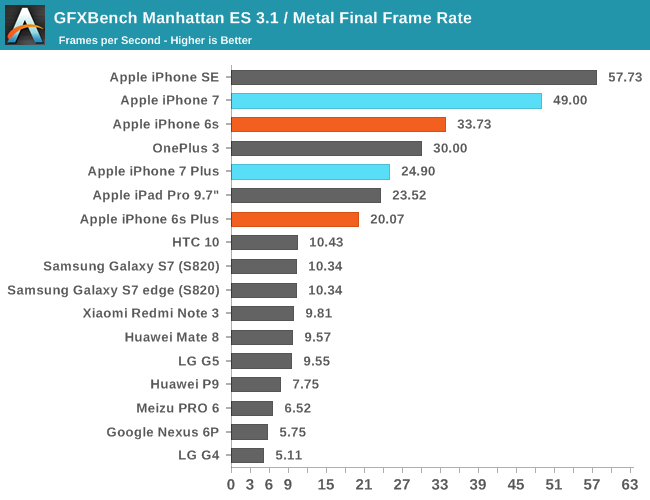
Moving past the web browsing test we use we can take a look at how the iPhone 7 Plus throttles. Unfortunately Basemark OS II was basically broken in this regard for the CPU rundown test so we can only look at how it behaves on Manhattan 3.1, but it's interesting to see how the GPU performance drops about 40% for the iPhone 7 Plus while the iPhone 7 throttles around 20%, because even Manhattan 3.1 is pegged to vsync which means that the GPU can spend much more time idling once a given frame is rendered. It's probably not a surprise here but the iPhone 7 just doesn't last very long here because battery life is strongly SoC-bound. If you attempted to plot battery life as a function of overall SoC utilization, it's entirely possible that the iPhone 7 might last longer than the 7 Plus at the lower bound for utilization, but as soon as you go past web browsing and similarly "light" tasks the 7 Plus and most phablets are going to strongly outperform such a small phone. Here the larger battery helps to get the iPhone 7 Plus nearly another hour of battery life when the SoC is under full, continuous load.
Charge Time
As usual, while battery life is the salient characteristic that determines overall mobility, it’s important to not ignore charge time as there are a number of edge cases where charging has a significant impact on overall mobility. In order to test this we use power measurements at the wall and measure the time it takes from the moment that the charger is plugged in to the moment that it falls below a pre-determined draw from the wall. While this isn’t perfect due to varying levels of DC conversion efficiency and different methods of trickle charging, this method provides at least a reasonable approximation of how long it will take to charge a device.
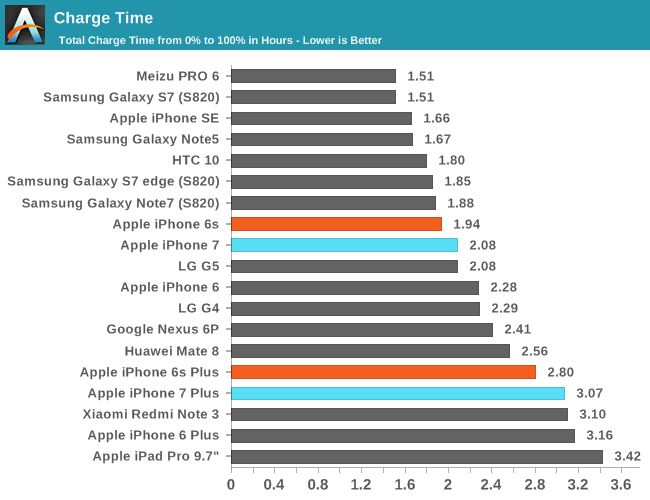
In the case of the iPhone 7 and 7 Plus, Apple continues to ship their standard 5W chargers for US variants. Looking at the results, it’s probably obvious that at least in the case of the iPhone 7 Plus, there is a very real need for Apple to start shipping something with faster charging, as the standard 5W charger takes a full hour longer than most of its competition to charge to 100%. Even the iPhone 7 could use a higher power charger here as using the device while it is charging will significantly impact the charging rate as the charger cannot supply enough power to the board while also charging the battery. And in the case of both phones, the lack of a high power charger doesn't just draw out the total charge time, but it also precludes rapid charging (partially charging a depleted phone very quickly) as well.
It would really be prudent for Apple to start to transitioning to higher power AC adapters at this point. This doesn’t take away from how impressive battery life is, but overall mobility isn’t going to be better than the competition unless you go out of your way to buy an iPad charger.


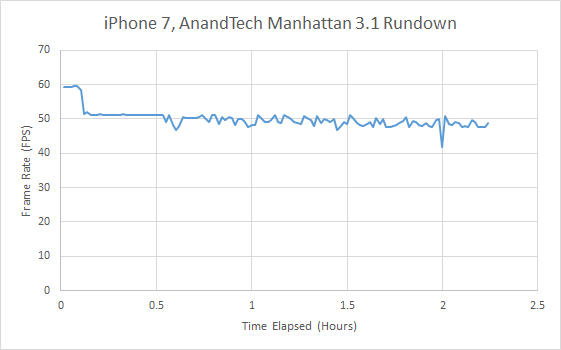
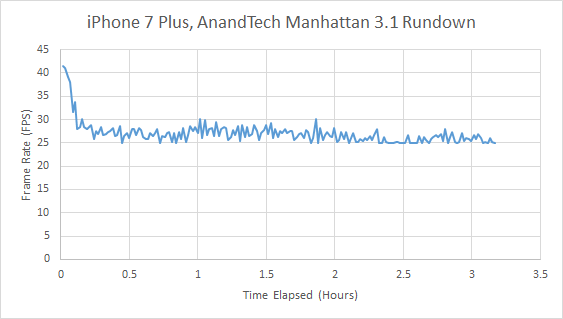
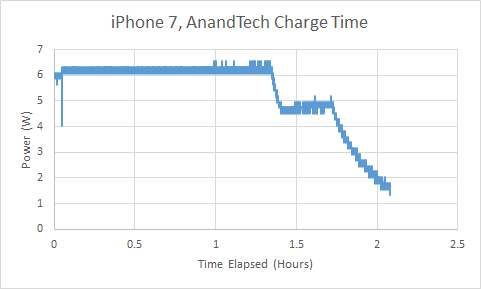
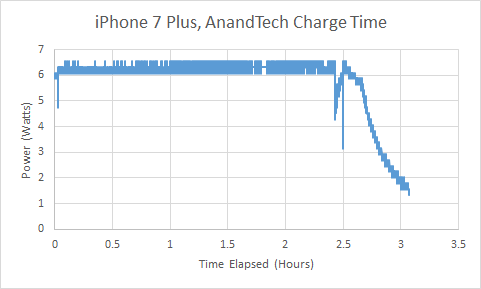








377 Comments
View All Comments
zodiacfml - Thursday, October 13, 2016 - link
Yep. The Google Pixel(s) is claimed to shoot HDR almost instantaneously which is useful to me. I don't use it if I will need flash photography on my Nexus 5. HDR is a must in most cases. White Balance is hard to fault after the HDR process.techconc - Thursday, October 13, 2016 - link
Well said. I suppose if people simply use their phones for texting, they wouldn't understand why more power is needed. I'm looking at what the iPhone 7 plus is doing with showing real time previews of fake bokeh on images in portrait mode. It's absolutely amazing what they are accomplishing on a phone these days.For that matter, try playing a game like World of Tanks Blitz on the Nexus 5X. Trust me, iPhone owners like users like them. It helps them pad their stats with more kills, etc. Honest, this "why do we need more performance" argument is pretty comical.
zodiacfml - Thursday, October 13, 2016 - link
You have a point there and I still use a Nexus 5 everyday. It is plenty fast 95% of the time and only lags during app updates which I don't mind. It is perfectly usable while doing its tasks of downloading and installing updates.I'm itching for new hardware though as the Nexus 5 could use an AMOLED display, larger battery, and external storage. A new SoC can help though with better battery life at idle or average tasks.
Yeah, I guess you are right about the 820. The 820 is impressive if found on devices around the price range of the One Plus 3. Androids with costs near an iPhone 7 is not good value.
omeryounos - Wednesday, October 12, 2016 - link
@Anadtech, really clever review. You guys totally omitted Galaxy S7 Edge (with Exynos 8890) from system performance & battery test to showcase Apple's greatest innovation ever. Especially your comments in Battery life section stating that look how much better it is from Galaxy S7 (Exynos) & omit any results from Galaxy S7 Edge (Exynos), knowingly that it will beat both iPhone 7 & Plus hands down in all battery test by hours. We (the readers) expect more balanced reviews from this site especially when it is coming weeks later than most mobile sites.BenSkywalker - Wednesday, October 12, 2016 - link
I'm curious why you didn't dive far more into Apple's utterly staggering breakthrough in LCD technology-"However, I think AMOLED's color shifting off angle puts it at a disadvantage"
Out of the hundreds of in depth instrumented tests I have witnessed and comparing hundreds of displays never have I seen a single LCD that was capable of besting *any* OLED in off angle performance- actually given the physics involved and how the displays are built, this is widely considered impossible. Given how extremely simple this is to test, I'm a bit confused as to why you haven't documented this industry changing technology and exactly what level of off angle performance improvement it shows over every other LCD ever made.
I saw the comments about off angle OLED colors being an issue in the laptop review posted a short while ago, figured you must have had a defective unit(the *only* explanation)- now you are saying this iPhone7 display bests all AMOLEDs at off angle color accuracy- really hoping you can post your measured results with exactly what degree of variation you are seeing.
Displaymate must have tested something wrong, they are still showing the iPhone7 with a catastrophic 55% drop off for brightness with some color shifting too at a mere thirty degrees, two of the photos on the front page of your review I think are also mislabeled, they say they are iPhone7 but they are showing abhorrent off angle viewing- they must be of some other, non Apple, phone.
JoshHo - Wednesday, October 12, 2016 - link
I think it goes without saying that LCD will have greater off-angle contrast reduction than AMOLED, but for color accuracy you can look at the dE2000 formula and see that changes in hue are more significant than changes in luminance in human perception of color. You can also see DisplayMate's results to see that the iPhone 7 has about a third of the color shift of the Note7's display with changes in viewing angle which is due in part to the subpixel arrangement:http://www.displaymate.com/iPhone7_ShootOut_1.htm
http://www.displaymate.com/Galaxy_Note7_ShootOut_1...
If you have any other questions or concerns please feel free to contact me by email as I don't have the time to sift through hundreds of comments searching for responses. My email is josh@anandtech.com.
philehidiot - Wednesday, October 12, 2016 - link
What I would like to see is a more in depth look at the sound quality. Not through the speakers but through headphones. The reason for this is that I attached a pair of monitoring headphones to my HTC M9 and found the top end to be incredibly harsh and distorted but when plugging those same headphones into my tablet (Kindle Fire 7 HDx) the sound was far better and there was no distortion. I would guess Apple would have better sound than the competition but a paragraph on wired headphone performance would be good and might well push more manufacturers to improve in this area. Interestingly, the Dolby "enhancements" make cheap headphones sound a load better but make decent monitoring headphones sound far worse - I assume this is because the compression applied to bring the sound into the limited dynamic range of the cheaper headphones actually helps but on the more expensive ones which can reproduce the full dynamic range of the recording it just effectively narrows it. Someone please correct me if I'm talking bollocks.UtilityMax - Wednesday, October 12, 2016 - link
For me, the iPhones do not exist, because I own a large media collection and I can't upload any of it to the iPhone without going through slow and buggy iTunes. On top of that, the iPhones do not exist for me after the 7 release after they deleted headphone jack. I own several audiophile grade but still very affordable headphone, and not of them can be used with it. I'd have to replace each one of them with a different set that costs something 2-3 times more and the benefits of doing that are pretty much dubious.So yes, in my world view, I would take a Moto G over the iPhone any day.
blackcrayon - Wednesday, October 12, 2016 - link
Sounds like you don't understand iPhones or iOS if you think you *HAVE* to use iTunes to put media on it... Hell, you don't even seem to know that they come with a headphone jack adapter for all of your "audiophile grade" headphones...UtilityMax - Wednesday, October 12, 2016 - link
I understand the iOS and issues very well. There are ways to bypass iTunes, then they still suck big time. As for the headphone jack, you can keep the headphone adapter to yourself. I am not carrying it, when it is about million times more convenient not to have to use it.